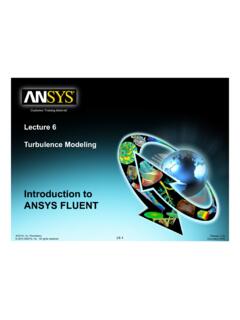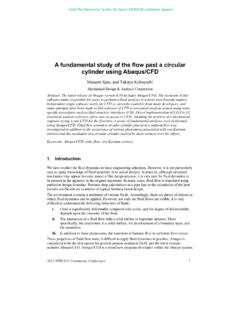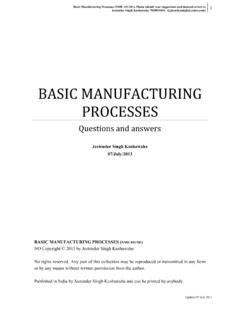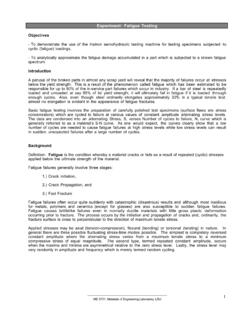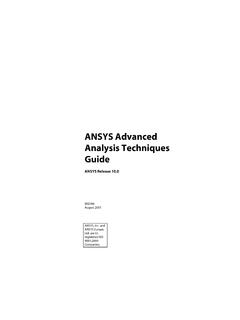Transcription of Introduction toIntroduction to ANSYS FLUENT
1 Customer Training Material L t Lecture 5. solver Settings g Introduction to ANSYS FLUENT . ANSYS , Inc. Proprietary Release 2010 ANSYS , Inc. All rights reserved. L5-1 December 2010. solver Settings solver Settings - Introduction Customer Training Material So far we have looked at how to setup a basic flow simulation in FLUENT . However you should not assume that just because you have an an answer'. answer that that is the correct answer'. By modifying the solver settings you can improve both: The rate of convergence of the simulation The accuracy of the computed result. ANSYS , Inc. Proprietary Release 2010 ANSYS , Inc. All rights reserved. L5-2 December 2010. solver Settings Solution Procedure Overview Customer Training Material The sketch opposite shows Set the solution parameters the basic workflow for any simulation.
2 Initialize the solution This lecture will look at: Enable the solution monitors of interest the choice of solver Modify solution discretisation schemes Calculate a solution parameters or grid checking convergence assessingg accuracyy Check for convergence g Yes No Check for accuracy No Yes Stop ANSYS , Inc. Proprietary Release 2010 ANSYS , Inc. All rights reserved. L5-3 December 2010. solver Settings Available Solvers Customer Training Material There are two kinds of solvers available in FLUENT : Pressure-Based Pressure-Based Density-Based Pressure based (segregated) (coupled) (coupled). Density based Solve U-Momentum The pressure-based solvers take Solve V-Momentum Solve Mass, momentum and pressure (or pressure Solve Mass Momentum, Solve W-Momentum & Momentum Energy, gy, correction) as the primary primar variables.
3 Ariables Species Pressure-velocity coupling algorithms Solve Mass are derived by reformatting the Continuity;. continuity equation Update Velocity Two algorithms are available with the Solve Energy pressure-based solvers: Segregated g g solver Solves for S l Species Solve S i pressure correction and momentum sequentially. Coupled solver (PBCS) Solves Solve Turbulence Equation(s). pressure and momentum simultaneously. i lt l Solve Other Transport Equations as required ANSYS , Inc. Proprietary Release 2010 ANSYS , Inc. All rights reserved. L5-4 December 2010. solver Settings Available Solvers Customer Training Material Density-Based Coupled solver Equations for continuity, momentum, energy and species (if required) are solved in vector form form. Pressure is obtained through an equation of state.
4 Additional scalar equations are solved in a segregatedt d ffashion. hi The DBCS can be run either explicit or implicit. Implicit Uses a point-implicit Gauss- Seidel / symmetric block Gauss-Seidel /. ILU method to solve for variables. Explicit: uses a multi-step Runge-Kutta explicit p time integration g method ANSYS , Inc. Proprietary Release 2010 ANSYS , Inc. All rights reserved. L5-5 December 2010. solver Settings Choosing a solver Customer Training Material The pressure-based solver is applicable for a wide range of flow regimes from low speed incompressible flow to high-speed compressible flow. Requires less memory (storage). Allows flexibility in the solution procedure. The pressure-based coupled solver (PBCS) is applicable for most single phase flows, and yields superior performance to the standard pressure-based solver .
5 Not N available il bl ffor multiphase li h (E. (Eulerian), l i ) periodic i di mass-flow fl and d NITA cases. Requires 2 times more memory than the segregated solver . The density density-based based coupled solver (DBCS) is applicable when there is a strong coupling, or interdependence, between density, energy, momentum, and/or species. Examples: High speed compressible flow with combustion, hypersonic flows, shock interactions. interactions The implicit option is generally preferred over explicit since it has a very strict limit on time step size The explicit approach is used for cases where the characteristic time scale of the flow is on the same order as the acoustic time scale scale. (e ( g propagation of high-Ma high Ma shock waves). ANSYS , Inc.)
6 Proprietary Release 2010 ANSYS , Inc. All rights reserved. L5-6 December 2010. solver Settings Discretisation Customer Training Material In FLUENT , solver variables are stored at the centre of the grid cells (control volumes). Recall the general form of the transport equations shown in an earlier lecture: To implement these equations, we need to know the values of this quantity at the faces of the control volumes, l andd th di t off for the gradients f the th grid id cell. ll The following slides show the options available for p g the cell-centre data,, and these are set interpolating as Solution Methods'. Value ( Velocity) computed here ANSYS , Inc. Proprietary Release 2010 ANSYS , Inc. All rights reserved. L5-7 December 2010. solver Settings Discretisation (Interpolation Methods) Customer Training Material Field variables (stored at cell centers) must be interpolated to the faces of the control volumes.
7 Value ( Velocity) computed here But solver must estimate the value at each face so the flux can be computed Interpolation schemes for the convection term: First-Order Upwind Easiest to converge, only first-order accurate. Power Law More accurate than first-order for flows when Recell < 5 (typ. low Re flows). Second-Order Upwind Uses larger stencils for 2nd order accuracy, essential with tri/tet mesh or when flow is not aligned with grid; convergence may be slower slower. Monotone Upstream-Centered Schemes for Conservation Laws (MUSCL) Locally 3rd order convection discretisation scheme for unstructured meshes; more accurate in predicting secondary flows, vortices, forces, etc. Quadratic Upwind Interpolation (QUICK) Applies to quad/hex and hybrid meshes, useful for rotating/swirling flows, 3rd-order accurate on uniform mesh.
8 ANSYS , Inc. Proprietary Release 2010 ANSYS , Inc. All rights reserved. L5-8 December 2010. solver Settings Interpolation Methods (Gradients) Customer Training Material Gradients of solution variables are required in order to evaluate diffusive fluxes, velocity derivatives, and for higher-order discretisation schemes. The gradients of solution variables at cell centers can be determined using three approaches: G. Green-Gauss G Cell-Based C ll B d Least L t computationally t ti ll intensive. i t i S. Solution l ti may h have ffalse l diffusion. Green-Gauss Node-Based More accurate/computationally intensive; minimizes false diffusion; recommended for unstructured meshes. Least-Squares Cell-Based Default method; has the same accuracy and properties as Node-based Gradients and is less computationally intensive.
9 ANSYS , Inc. Proprietary Release 2010 ANSYS , Inc. All rights reserved. L5-9 December 2010. solver Settings Interpolation Methods for Pressure Customer Training Material Interpolation schemes for calculating cell-face pressures when using the pressure-based solver in FLUENT are available as follows: Standard The default scheme; reduced accuracy for flows exhibiting large surface-normal pressure gradients near boundaries (but should not be used when steep pressure changes are present in the flow PRESTO! scheme sho ld be used should sed instead instead.)). PRESTO! Use for highly swirling flows, flows involving steep pressure gradients (porous media, fan model, etc.), or in strongly curved domains Linear Use when other options result in convergence difficulties or unphysical behavior Second-Order Use for compressible flows; not to be used with porous media,, jump, j p, fans,, etc.
10 Or VOF/Mixture multiphase p models Body Force Weighted Use when body forces are large, , high Ra natural convection or highly swirling flows ANSYS , Inc. Proprietary Release 2010 ANSYS , Inc. All rights reserved. L5-10 December 2010. solver Settings Pressure-Velocity Coupling Customer Training Material Pressure-velocity coupling refers to the numerical algorithm which uses a combination of continuity and momentum equations to derive an equation for pressure (or pressure correction) when using the pressure-based solver . solver Five algorithms are available in FLUENT . Semi-Implicit Method for Pressure-Linked Equations (SIMPLE). The default scheme, robust SIMPLE-Consistent (SIMPLEC). Allows faster convergence for simple problems ( , laminar flows with no physical models d l employed).
